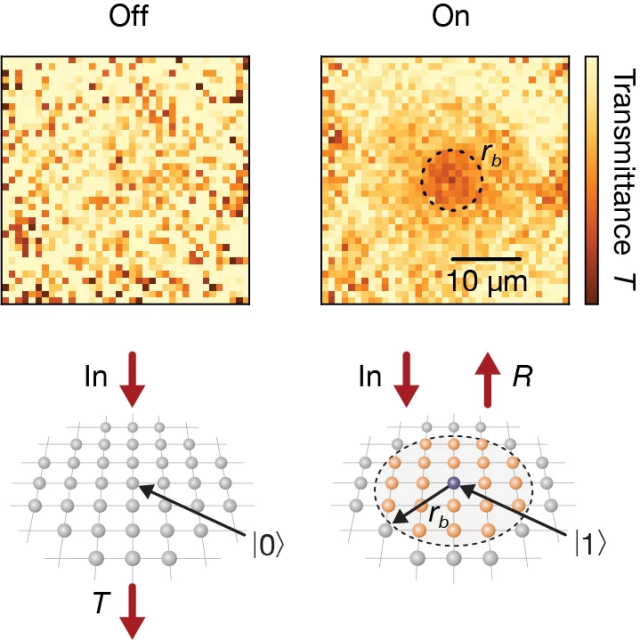22 February 2023
A quantum switch for the world’s lightest mirror
Researchers at MPQ have created a switchable metamaterial: an atomic array whose optical qualities can be tuned to become either reflective or transparent. The findings, which appeared in Nature Physics, build on team’s previous research on so-called “ordered atomic arrays” that enable efficient interaction between light and atoms. By introducing an additional, microscopically controlled single “quantum switch” atom into the array, the scientists succeeded in switching the optical characteristics of the material on demand.
Revisiting the world’s lightest mirror
 © MCQST | C. Hohmann
© MCQST | C. Hohmann Concretely, the research team assembled Rubidium atoms in a fixed two-dimensional regular pattern at distances below the wavelength of an incoming photon: “We want the atoms to be arranged at a sub-wavelength distance because that is when they act “cooperatively”. That means that the atomic array as a whole inherits some properties of single atoms, but at much higher effective light-matter coupling strength”, Kritsana Srakaew, doctoral student and first author of the paper, explains. As a consequence of the increased light-matter coupling, even a single photon that would pass a single atom is likely to be reflected very efficiently. This realises the world’s lightest mirror, which consists of just a single layer of atoms.
Using a single atom as a quantum switch
 © MPQ
© MPQ More specifically, the authors devised a switch consisting of a single atom – the smallest possible solid switch. This switch is placed at the very centre of the optical mirror, the ordered array of atoms. Its mechanism hinges on the atom’s energy state, which can be manipulated using laser light. Depending on the energy state, the optical mirror will then be reflective or transparent like a window. “The results are very exciting for us. Guiding single photons is a challenging task, which is typically accompanied with losses or strong geometric restrictions. Atomic arrays have the potential to address both challenges”, says Pascal Weckesser, postdoctoral researcher and second author. He further adds: “It is fascinating to switch single photons by either sending them one way or the other, especially as we only manipulate a single atom to do so.”
In addition, the researchers’ work explores some key quantum characteristics. In their experiment, the switch cannot only be prepared in the two limiting settings “0” and “1”, but more importantly, it can be tuned to an in-between state. This quantum feature therefore allows settings that have no classical analogue, such as a mirror, which is both reflecting and transmitting at the same time
Paving the way towards reliable atom-light entanglement
The presented work provides important ingredients for atom-light entanglement. Preparing the quantum switch in a coherent superposition between the ground and the excited state (the “on” and “off” setting - “0” and ”1”) creates atom-light entanglement, a unique and strange connection between the incoming photon and the atomic switch. “Atom-light entanglement is a crucial requirement for quantum networks, where information is transferred from stationary qubits like atoms to flying qubits like photons. The presented switchable mirror demonstrates an entirely new ansatz to realize atom-light entanglement, that is of fundamental interest and may have a number of applications in quantum technologies.”, adds Johannes Zeiher, Principal Investigator of the study.
Source: MPQ Website
Publication
A subwavelength atomic array switched by a single Rydberg atom
K.Srakaew, P.Weckesser, S. Hollerith, D.Wei, D. Adler, I. Bloch & J. Zeiher
Nature Physics (2023)
DOI:
10.1038/s41567-023-01959-y
Contact
Dr Pascal Weckesser
Postdoctoral researcher
pascal.weckesser[at]mpq.mpg.de
Max Planck Institute of Quantum Optics, Garching
Kritsana Srakaew
Doctoral student
kritsana.sakraew[at]mpq.mpg.de
Max Planck Institute of Quantum Optics
Johannes Zeiher
Research Group Leader
johannes.zeiher[at]mpq.mpg.de
Max Planck Institute of Quantum Optics
Charlotte Huber
PR and Communications
charlotte.huber[at]mpq.mpg.de
Max Planck Institute of Quantum Optics
